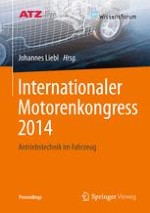2014 | OriginalPaper | Chapter
Aspects on injection pressure for diesel and gasoline DI engines
Authors : Jürgen Hammer, Prof. Dr., Roger Busch, Dr.-Ing.
Published in: Internationaler Motorenkongress 2014
Publisher: Springer Fachmedien Wiesbaden
Activate our intelligent search to find suitable subject content or patents.
Select sections of text to find matching patents with Artificial Intelligence. powered by
Select sections of text to find additional relevant content using AI-assisted search. powered by
Since the very beginning of providing fuel metering equipment for combustion engines, injection pressure is a key enabler for mixture preparation and spray performance, fulfilling the task to bring the fuel into the combustion chamber in the right time, with the right quality to the right place. This paper deals with the role of injection pressure for Diesel and Gasoline Direct Injection combustion processes.
Future requirements on propulsion coming from the overall market trends especially on emission and CO
2
by means of fuel consumption are discussed. As the key technology for internal combustion engines direct fuel injection in Gasoline and Diesel plays a major role gaining the challenging development targets like power output, comfort, lowest emission and benchmark fuel consumption at attractive cost level. This trend is already established in Western Europe and North America followed by the Asia market and will be rolled out in the next upcoming decade. There is no alternative than using that technology in a broad manner fulfilling overall CO
2
emission legislation.
Diving deeper in the DI technologies one obtains the injection pressure as main key performance indicator. Looking at Diesel the energy cascade starts from pressure via spray momentum to spray penetration and ends up in a vapor liquid multi phase fluid which is burned in the combustion chamber in order to realize best combustion results defines the core of injection technology. Some multidimensional optimization of contradictionary targets is discussed and results are shown. Consequences on the system and component layout follow to deliver high pressure injection technology in a most efficient way.
Looking on the gasoline side the main target on DI technologies is avoiding particulates by simultaneously realizing best fuel consumption at lowest raw emissions. Further investigation leads to the rule of avoiding wall wetting of the piston roof as well as the valve and cylinder head area. In addition late fuel evaporation which is initially layered as a fluid film which lands on the injector tip or other surfaces in the combustion chamber should be minimized. Discussion sources of particulates and measures to reduce them are followed by engine results showing best emissions and lowest fuel consumption in parallel. From system and component point of view key measures to provide high injection pressure are described.
Finally on both Gasoline and Diesel side the need of high injection pressure is summarized and of course the way to do so most efficiently closes the paper.
